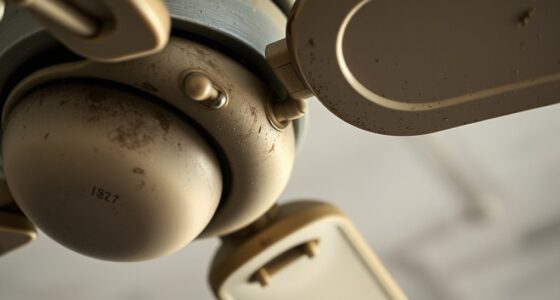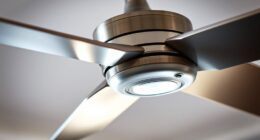To clean your ceiling fan light fixtures and globes safely and effectively, first turn off the power and wait for everything to cool down. Remove the globes carefully, supporting them on a soft surface, then gently wipe with a soft, damp cloth using mild soap if needed. Use compressed air or a small brush for tight spots, and inspect sockets for dust or corrosion. Proper reassembly and regular maintenance will keep your fixtures bright and function at their best—more insights await.
Key Takeaways
- Turn off the fan and power before cleaning to ensure safety and prevent electrical hazards.
- Carefully remove light globes and fixtures, following manufacturer instructions, and place globes on a soft surface.
- Use a soft, damp cloth with mild soap to gently wipe globes and fixtures, avoiding abrasive materials or harsh chemicals.
- Soak heavily soiled globes in warm, soapy water, then rinse and dry thoroughly before reinstallation.
- Inspect sockets and fixtures for dust, corrosion, or damage, and ensure everything is dry and securely reassembled before restoring power.

Regularly cleaning your ceiling fan light fixtures and globes is essential to maintain ideal brightness and prevent dust buildup that can diminish illumination. Dust and grime accumulate on surfaces over time, reducing the efficiency of light output and potentially causing discoloration or surface degradation. A thorough cleaning process ensures that light fixtures operate at peak performance, providing consistent illumination throughout the space. To achieve this, you must first turn off the power supply to prevent electrical hazards and allow the fixtures to cool if recently used. Carefully remove the globes or covers, following manufacturer instructions to avoid damage, and set them aside on a soft surface to prevent scratches.
Regularly clean ceiling fan globes to maintain brightness and prevent dust buildup.
Next, inspect the fixtures for dust, cobwebs, or insect debris, which can obscure the light source and impair luminance. Use a soft, lint-free cloth or microfiber cloth to gently wipe surfaces, ensuring the removal of loose dust particles. For stubborn grime or greasy residue, dampen the cloth slightly with a mixture of mild soap and water, avoiding excess moisture that could seep into electrical components. When cleaning glass globes, avoid abrasive materials or harsh chemicals, as these can cause scratching or surface deterioration. If the globes are particularly dirty, soak them in warm, soapy water for a few minutes before rinsing and drying thoroughly.
Pay close attention to the light sockets, ensuring they are free of dust and corrosion. Use a small brush or compressed air to dislodge debris from tight spots or vents. If you notice any corrosion or oxidation, consider replacing affected components to maintain electrical integrity. When reinstalling the globes, ensure they are properly aligned and securely fastened to prevent loosening or falling during operation. Double-check that all fixtures are dry before restoring power, as residual moisture can cause short circuits or damage. Additionally, properly calibrating your lighting can help optimize brightness and color accuracy for a better visual experience.
Regular maintenance also involves inspecting the fixture’s structural elements for signs of wear, such as cracks or loose screws. Tighten any loose components carefully, using appropriate tools to avoid stripping threads or damaging fixtures. Establish a routine cleaning schedule—typically every few months—based on environmental conditions and fixture exposure to dust or insects. Consistent cleaning not only maximizes illumination efficiency but also prolongs the lifespan of the fixtures and globes, reducing the need for costly repairs or replacements. By adhering to these detailed procedures, you ensure your ceiling fan light fixtures remain in excellent condition, providing bright, clear lighting with minimal maintenance effort.
Frequently Asked Questions
How Often Should I Clean My Ceiling Fan Light Fixtures?
You should clean your ceiling fan light fixtures every 3 to 6 months to prevent dust and grime buildup that can reduce brightness and attract pests. Regular cleaning involves turning off the power, removing globes or covers carefully, and wiping surfaces with a damp cloth and mild detergent. For maximum performance, inspect and clean the fixtures more frequently if you notice dust accumulation or if you use your fan heavily in dusty environments.
Can I Use a Steam Cleaner on Ceiling Fan Globes?
Using a steam cleaner on ceiling fan globes is like playing with fire—potentially damaging delicate surfaces. Most globes are made of glass or plastic, which can crack or warp under high heat or moisture. Instead, opt for a soft cloth dampened with a mild detergent or glass cleaner. Carefully wipe the globes, avoiding excess moisture, to preserve clarity and prevent damage, ensuring your lighting stays bright and intact.
Are There Eco-Friendly Cleaning Options for Ceiling Fan Lights?
Yes, eco-friendly cleaning options exist for ceiling fan lights. You can use a mixture of equal parts water and white vinegar, which effectively removes dust and grime without harsh chemicals. Alternatively, a gentle, biodegradable detergent diluted in water works well. Always turn off the power, remove the globes carefully, and use a soft cloth or sponge to clean. These methods guarantee thorough cleaning while minimizing environmental impact.
What Safety Precautions Should I Take Before Cleaning?
Imagine a shield protecting you before a delicate task. Turn off the fan and power supply, ensuring no electricity flows, like sealing a vault. Use a sturdy ladder for stability, avoiding overreach. Wear gloves to prevent smudges and safety glasses against debris. Confirm the fan blades are stationary, preventing accidental movement. These precautions create a safe environment, reducing risk while you meticulously clean light fixtures and globes.
How Do I Prevent Dust Buildup on Ceiling Fan Globes?
To prevent dust buildup on ceiling fan globes, regularly dust them with a microfiber cloth or a soft brush to remove surface particles. Consider applying a thin layer of glass cleaner or a mixture of water and mild detergent periodically, then wipe clean to inhibit dust adhesion. Installing dust-repellent coatings specifically designed for glass surfaces can also reduce accumulation. Maintain a consistent cleaning schedule to ensure globes stay clear and free of dust.
Conclusion
Maintaining your ceiling fan light fixtures and globes is like tending to a well-worn lens—clarity depends on regular care. By following meticulous cleaning techniques, you guarantee ideal light quality and extend the life of your fixtures. Remember, neglecting these details can cloud your space’s ambiance, much like fog obscures a clear view. Stay diligent, and your lighting will continue to shine brightly, illuminating your home with precision and efficiency.








